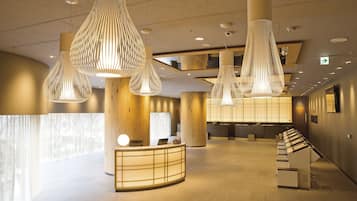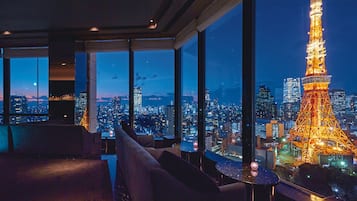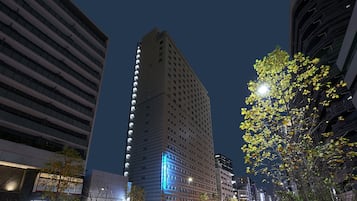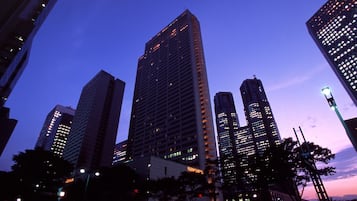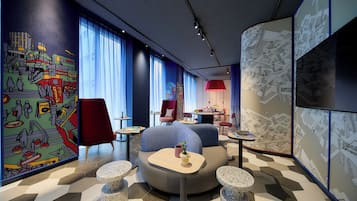Japan’s capital of Tokyo is where you can enjoy every conceivable cuisine from around the world. The city is packed full of fascinating places for foodies to check out – from centuries-old establishments continuing with traditional cuisine to new restaurants serving modern creative dishes.
But of course, you’ll definitely want to try out the ever-popular staples of Tokyo dining, so here we take a look at some prime examples: the Edomae (old Tokyo-style) takes on 3 dishes of sushi, soba and tempura, the local cuisine found in the Shitamachi (low-lying) area and fishing villages, celebrated Japanese sweets and beyond.
- 1
Edomae tempura

- Food
Edomae tempura is a classic take on everyone’s favourite batter-coated Japanese fried delicacy. This dish consists of seafood from Tokyo Bay that’s coated in batter and fried with sesame oil until crispy and golden brown. In Kansai, tempura is typically enjoyed with salt but in the Kanto region, the most popular way to eat it is with grated daikon radish and a salty-sweet tsuyu (dipping sauce).
Tempura’s roots go back around 400 years, and this western-style fried food was actually inspired by the same Portuguese influences that brought gun technology to Japan. It was originally sold on skewers from little food carts, which became very popular with the masses. You can find famous Edomae tempura restaurants throughout Tokyo, especially in areas such as Kyobashi, Tsukiji and Akasaka. Make sure you check out tempura restaurants with tatami rooms (ozashiki tempura) where skilled chefs fry the tempura right in front of you, using fresh seafood ingredients such as kuruma shrimp, conger eel, goby, and sillago.
- 2
Ramen

- Food
Tokyo brings together all kinds of ramen restaurants from across Japan. You can find light and thick ramen dishes, with bases using soy sauce, salt, miso, seafood, pork belly and bones (tonkotsu). There are also unique takes on ramen that are difficult to even categorise. Tokyo even has ramen restaurants awarded with the much-coveted Michelin stars.
Soy sauce ramen (shoyu ramen) is said to have originated in Tokyo’s Asakusa district. It’s also mainly based on chicken broth (torigara soup), with menma (seasoned bamboo shoots), finely chopped scallion and thinly sliced roasted pork fillet (chashu) particularly popular toppings. Tsukemen (cold noodles with dipping soup) was created in Tokyo's Nakano ward. Abura soba, eaten in a soup-less dip and coated with condiments, is a dish that hails from Musashino City in Tokyo. Places such as Ikebukuro, Shibuya and Shinjuku are known as fierce battlegrounds in the ramen scene, with new forms of ramen created almost every day.
- 3
Yanagawa nabe

- Food
Loach dishes have been popular among the common people of downtown Tokyo’s Shitamachi ever since the Edo period. Loach hotpot (dojo nabe) is a dish of whole loaches cooked in a pan with salty-sweet broth and topped with a generous helping of green onion. Loach-and-egg hotpot (yanagawa nabe) combines split loaches and burdock cooked with mirin and soy sauce, with beaten egg on top. If you put this mixture on top of rice, you get a loach-and-egg rice bowl (yanagawa don). Loach is a nourishing fish that contains a good balance of iron, calcium and protein. It’s also more affordable than eel (unagi). There are many established restaurants specialising in loach hotpots in Asakusa.
- 4
Monjayaki

- Food
Monjayaki is often compared to Osaka’s famous okonomiyaki. Originated in Tokyo’s Shitamachi district, it was popular as a snack that children could buy at candy stores. This delicacy is made with Worcestershire sauce and ingredients combined with wheat flour, but mixed much more loosely than that of okonomiyaki, and cooked on an iron plate.
A wide range of ingredients can be used, including cabbage, shredded and dried squid (saki-ika), fried tempura batter scraps (agedama), pollack roe (mentaiko), sakura shrimp, cheese and mochi. These ingredients are stir-fried first before they're formed into a circular bank (dote) using a metal spatula. Pour the batter into the middle let it simmer until cooked. You enjoy monjayaki by scraping a little bit of it at a time with a smaller metal spatula. The best thing about this dish is the combination of crispy and sticky textures. Tsukishima Monja in the Chuo ward is one of Tokyo's go-to restaurants for this dish.
- 5
Fukagawa-meshi

- Food
Fukagawa-meshi is a local Tokyo dish of rice topped with simmered vegetables, such as green onion and fresh Japanese littleneck clams mixed with soybean paste. It’s a popular everyday meal for the busy fishermen of Fukagawa, which flourished as a fishing town in the Edo period. The common Orient and saltwater clams are also used in this dish.
Another variation of Fukagawa meshi is a simple dish of rice cooked with vegetables and clams. Sometimes called clam rice (asari meshi), local carpenters often enjoy it thanks to its convenience and portability. Both versions are equally delicious, and there are restaurants offering both dishes. You can also top the dish with seaweed for added flavour.
photo by Yuki Shimazu (CC BY-SA 2.0) modified
- 6
Anmitsu

- Food
Anmitsu is a dessert that comes from a sweet red bean soup shop in Ginza. It served traditional mitsumame – cubed agar jelly, fruits, and red peas – that’s topped with anko (red bean paste) and brown sugar syrup. Toppings for anmitsu now vary from shop to shop, ranging from matcha or vanilla ice cream and fresh fruit to sticky rice balls (shiratama) and soft rice cake (gyuhi). You can find this colourful dessert at many cafes and restaurants throughout Tokyo, particularly in the Asakusa and Ginza districts.
photo by Hajime NAKANO (CC BY 2.0) modified
- 7
Edomae sushi

- Food
Edomae sushi (or nigirizushi), where the topping tends to be fish from Tokyo Bay, is a key element of the Japanese capital’s local cuisine. It became popular amongst the people of Edo (the old name for Tokyo) at the beginning of the 1800s as a kind of fast food. If you’re struggling to decide which sushi to try, it’s a good idea to start with tuna – the quality of which is said to determine the rank of a sushi restaurant. Also well worth trying are seasonal ingredients such as Japanese tiger prawn (kuruma-ebi), conger eel, giant clam, octopus, common orient clam (hamaguri) and blood clam (akagai).
Edomae sushi is also widely known for extra touches by sushi chefs. Simmered conger eel, broiled mackerel, vinegared spotted sardine, and cooked hen eggs are all good examples of these flourishes. Nigirizushi requires a perfect temperature for both the sushi rice and topping. To enjoy it at its best, each piece should be eaten as soon as it’s served on your table.
- 8
Chanko nabe

- Food
The hot-pot dish called chanko nabe came about when sumo wrestlers started to eat ingredient-rich hotpot dishes at the sumo stables in Ryogoku during the Meiji period. All meals served at sumo stables are called “Chanko”, and the ingredients and flavour of the hotpots can vary. Hotpot with chicken (mizutaki) or with chicken broth (soppu nabe) are mainly served at Chanko restaurants for the general public run by retired sumo wrestlers.
There are many famous chanko nabe restaurants around the Ryogoku Kokugikan Sumo Arena. Ingredients vary from restaurant to restaurant and may include chicken, pork, minced sardine balls, salmon, vegetables and mushrooms, but this dish is always healthy and stacked with ingredients regardless of where you choose to eat it. And don’t forget to choose either udon noodles or rice to add into the soup to finish off the meal.
photo by Jun OHWADA (CC BY 2.0) modified
- 9
Soba

- Food
Tokyo is a that has a long association with soba noodles -- so much so that there were around 4,000 soba restaurants here during the Edo period. There are 3 main soba varieties used in Edo soba – sunaba, sarashina and yabu. Sunaba soba has a long history and first appeared in Osaka. An excellent example is nihachi soba, which uses buckwheat flour and thickener at a ratio of 8:2. There are many restaurants in Tokyo’s Azabu area that serve sarashina soba, where the noodles are made only from the middle part of the buckwheat, producing a thin and pure-white strand. The soup tends to be on the sweet side.
Yabu soba uses flour from buckwheat that is ground with the husks left on, giving it a light green colour. It’s served with a salty soup on the side. The way to eat it by dipping just the tips of the noodles in the soup. This dish has its roots in Tokyo's Zōshigaya neighbourhood. Each of these varieties is unique, so your best bet is to try them all and see which you prefer.
- 10
Unagi

- Food
Unagi, or eel dishes, has been around for a very long time, but it was only during the Edo period on that they started to become popular among the common people. In Kanto, the eel is cut open from the back and the head is removed. Cooks often coat with a light and slightly sweet sauce before grilling it. The eel is steamed afterwards, resulting in a soft yet crispy consistency.
Eel restaurants in Tokyo range from famous and well-established venues where you can enjoy wild eels to local favourites that serve lunch at an affordable price. Even if it’s not the Midsummer Day of the Ox – which is a special day for eating eels in Japan – you can enjoy unagi eel dishes year-round. They are very nutritious, containing vitamin A and DHA. Have a bowl of unadon (eel rice bowl) as a way of recharging your energy while sightseeing in Tokyo.





